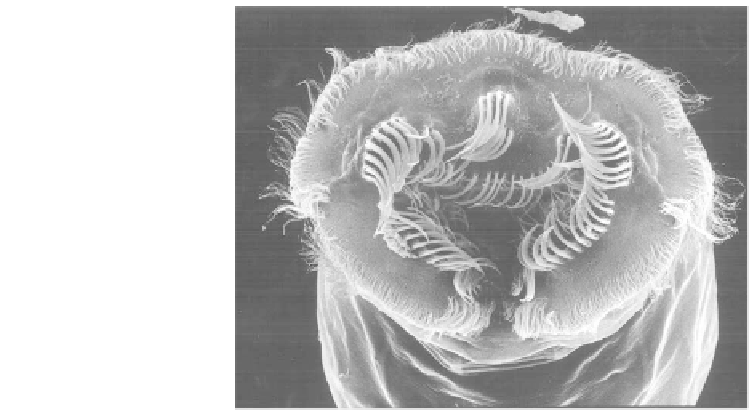Environmental Engineering Reference
In-Depth Information
FIGURE 18.11
The filter apparatus of a rotifer,
Epiphanes senta
(reproduced from G. Mel-
one, 1998,
Hydrobiologia
387/388,
131-134, Fig. 9, with kind permission from Kluwer Aca-
demic Publishers).
ria. Particle feeders may seem to be filtering or consuming particles indis-
criminately, but studies using a variety of methods to trace particle con-
sumption have shown that this is not necessarily the case. Inert particles such
as fluorescent plastic beads were ingested, but at reduced rates relative to live
bacteria of the same size (Sherr
et al.,
1987). This suggests that organisms
that feed on microbes are at least partially selective. Particle feeders will not
grow or reproduce as well when ingesting particles that are of poor nutri-
tional quality (Sterner, 1993; Tesseir and Consolatti, 1991), and they prefer
“soft” algae (DeMott, 1995). Thus, there is an evolutionary advantage for
selecting high-quality food, even for organisms that eat microbes.
Microbial Adaptations to Avoid Predation
Several adaptations have been described for avoiding predation, in-
cluding indigestibility, poor nutritional value, and chemical, behavioral,
and mechanical defenses. All these methods have evolved to be useful in
certain circumstances; I briefly discuss each of them.
Some unicellular algae are indigestible. They are able to pass through
the guts of grazers because of thick mucilage that protects them from diges-
tion. In addition to protection, these cells actually gain an advantage when
they are consumed. The zooplankton gut is a high-nutrient environment, and
luxury consumption of phosphorus by the algae in the process of passage
through the gut translates into an advantage after expulsion (Porter, 1976).
If cells have poor nutritional quality or manufacture toxic substances,
they may not be ingested or may cause the death of their predators. This
avoidance works only for cells that represent a relatively high proportion
of the diet of a predator. Toxins are diluted if few cells are consumed, and
higher quality food cells make up for low-quality cells. Cells found in mixed
assemblages, such as periphyton, a biofilm, or a diverse phytoplankton

Search WWH ::

Custom Search